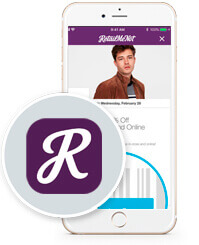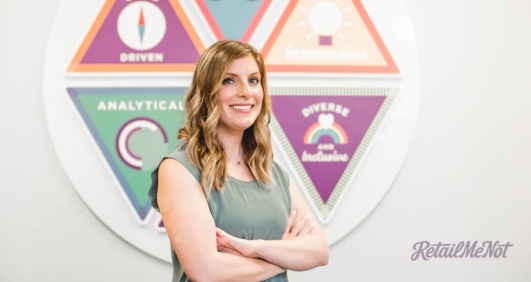Q&A with Amanda
This Q&A reflects Amanda's time as Sr. Manager, Digital & CRM at RetailMeNot. Currently, Amanda is Head of Marketing at AdBlock Inc..
Amanda’s career began at a small digital marketing agency in Austin, leading strategy for large consumer brands before mobile apps were prevalent in the space. When she joined RetailMeNot in 2013, she knew she wanted to move into consumer marketing, so began her focus on CRM. She dabbled in acquisition for RetailMeNot’s mobile app when she spearheaded a dynamic retargeting campaign on Facebook. From there, she expanded to new channels, which lead to managing all mobile app marketing for RetailMeNot. She now focuses on all performance marketing, leading the strategy behind growth and retention.
Read Amanda's latest article: "Mobile User Acquisition Marketing: Brand vs Performance"
In your own words, tell us about the app that you manage?
The RetailMeNot app delivers the best savings solutions to our consumers in the most relevant context, while driving value for our merchant and brand partners. RetailMeNot is constantly finding new ways to engage our core audience with the best savings from coupon codes to Cash Back Offers to Discount Gift Cards and more. The RetailMeNot app recently launched In-Store Cash Back Offers, where consumers can link their credit card to automatically receive savings the next time they shop in store.
How did you get started in mobile marketing?
After two years at RetailMeNot focusing on social and email, I wanted to learn more and expand my knowledge base. Around the same time, Facebook launched their dynamic product feed. I was one of the first users of Facebook’s business manager, as I have always been passionate about the impact of social media marketing on performance. I decided to help build a feed to re-engage RetailMeNot users, and the app was the perfect place to start. After spending some time managing RetailMeNot’s app acquisition through social, I began to expand to other channels, eventually taking over full management of the app.
What do you like most about mobile marketing?
My favorite thing about mobile marketing is how dynamic it is. It’s constantly evolving and bringing new challenges for marketers to overcome. Consumer behavior is also shifting toward mobile. In fact, 84% of household enthusiasts are apt to do their shopping on mobile devices. As marketers, we need to find our consumers where they are and make their purchasing decisions easier to make. Mobile marketing allows us to meet the consumer where they are and share the right message with them depending on where they are in the shopping journey.
What does it take to succeed in mobile marketing?
As a marketer, you need to be on top of the changes and nuances in mobile. Things can change quickly, and you need to be quick on the pulse to take advantage of those changes. With mobile marketing, there’s also opportunity to spearhead change. One thing I learned quickly is that if you ask the right question often enough, eventually the answer will start to shift. Never take ‘no’ for an answer, find a way to turn it into a ‘yes’!
What does a quality mobile user look like to you?
Every app marketer has a different quality metric that they align to, but we can all agree that quality is about the value you can bring to a real consumer. That value is shown through how they interact with your app. A quality user for RetailMeNot is someone who engages heavily with the app, and comes back often, because they’ve found value.
What strategies work best to convert installs into engaged users?
It’s important to ensure that the creative aligns to the landing experience. One thing we’ve tried to do at RetailMeNot is to align paid marketing to our app store and app landing page. If you plan to highlight a specific feature, make sure that feature is highlighted in the App and Play Store, and that the landing experience in the app communicates the value of that feature when they get there. Consumers don’t want to waste time trying to find content, so you have to serve it up to them in a way that’s easy for them to understand.
Retargeting is another great way to convert users into engaged app users, but in order to be most effective, it’s important to highlight a feature that they aren’t already aware of. We use retargeting to bring users in after they’ve visited the homepage to check out other features within the app, like In-Store Cash Back. It’s also important that you have the right measurement in place to measure incrementality and downstream actions post app open.
In the past year, what is one tip you can share which made the biggest performance difference with UA or re-engagement of your app?
We recently did a deep dive into our app metrics to create a predictive model to better understand what metrics tie to long-term retention. That opened the door for us to be very specific about the quality of users we’re bringing in at every stage and really evaluate our partners.
Another tip that’s a bit outside the box is something RetailMeNot did that helped us get on the same page with all of our partners. We hosted an “app partner day” at the beginning of the year and brought in all of our network partners to share common issues, fraud solutions, generate ideas for bringing new products to market, and better understand our 2018 goals. Sometimes getting everyone in the same room to share ideas is the best thing you can do!
How do you stay ahead of changes in technology?
Ask questions, rely on your agency partners, and sign up for every email list, Slack channel and Google group that you can.
What do you see as the next big thing in mobile app marketing?
Full-blown, 100% data transparency and cross-device connections. There are many things that are possible within mobile app marketing, but in a lot of ways, we are still behind desktop and mobile web. Once marketers can truly understand how users behave cross-device, we can drive even more relevant messaging to those users.
What advice can you offer to help marketers combat mobile ad fraud?
Don’t be afraid to speak up! If you look into your data and see something that doesn’t make sense, ask why, and expect a reasonable answer.






















